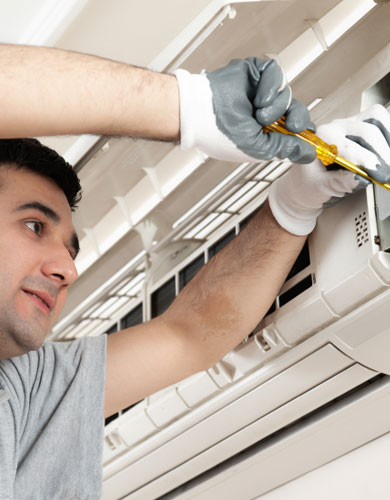DUCTLESS MINI-SPLITS
Incredible Comfort. Unbeatable Efficiency.
In the winter, a ductless mini-split draws heat from the outside air and circulates it into your home. In the summer, it reverses the process and draws heat from your interior air and releases it outdoors. It also dehumidifies the indoor air as it cools it.
Featured Ductless Mini-Splits
Good
Comfort-Aire 12000 BTU
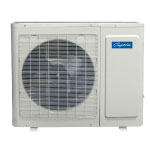
Side discharge condenser is compact in size with an alternative footprint to fit in tight spaces without detracting from landscaping and outdoor living areas, which also makes it great for apartment complexes and condominiums.
Better
Carrier - Ductless 12000 Btuh Heat Pump Single Zone w/ Basepan Heater
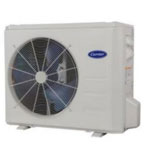
The 38MA*R series ductless split systems are a matched combination of an outdoor condensing unit and an indoor fan coil unit connected only by refrigerant tubing and wires. Extra-Low Temperature Heating Heat output up to 75% of rated capacity down to –22°F (–30°C), so when it’s cold outside, it will be warm inside, making this a primary heat source and eliminating the need for a backup heat source.
Best
Comfort-Aire 18000 BTU
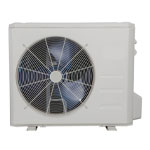
A perfect blend between budget limits, energy savings and comfort
The ductless systems are a matched combination of an outdoor condensing unit and an indoor fan coil unit connected only by refrigerant tubing and wires.
How does a Mini Split Work?
The mini split serves as an air conditioner by absorbing heat from indoor air and pumping it outdoors. The mini split contains an indoor coil which, in turn, contains a very cold liquid refrigerant. As indoor air passes over the indoor coil, the refrigerant-cooled coil absorbs heat from the air and so quickly cools that air.
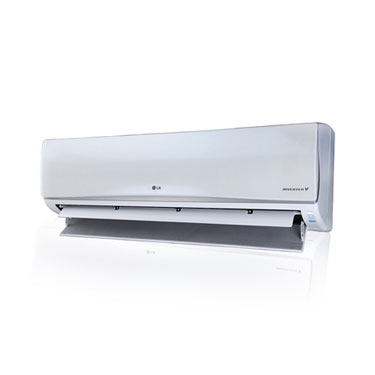
The cooled air cannot hold as much moisture as it did at a higher temperature. The excess moisture condenses on the outside of the coil, resulting in the dehumidification of the air. The cooled, dehumidified air is then forced (by a fan) to circulate throughout the space.

At the same time, the absorption of heat by the refrigerant turns the refrigerant from a liquid into a vapor. A compressor pumps the heat laden vapor through a vapor line to an outdoor coil which discharges the heat extracted from the indoor air. As the heat is discharged, the vapor is cooled and changes back into a liquid refrigerant. The refrigerant is then pumped back through a liquid line to the indoor coil and the cycle is repeated.
The mini split contains a reversing valve which reverses the flow of refrigerant and thus allows the mini split to serve as a heater during cold weather.
A mini split serves as a heater by absorbing heat from outdoor air and pumping it indoors. As the outdoor air passes over the outdoor coil, heat from that air is absorbed by the refrigerant contained inside the coil.
The absorption of heat changes the refrigerant from a low-temperature liquid to a low temperature, low-pressure vapor. The vapor then passes through a compressor where it is compressed into a high pressure, high temperature vapor. The hot vapor then circulates into the indoor coil. As indoor air passes over the indoor coil, it absorbs heat from the coil. The warmed air is then redistributed through the space.
Common Heating Problems
- Heating system is not working properly or turning on
- Can not regulate temperature
- Certain rooms or offices are too hot or too cold
- Heater air has odd odor
- Smell gas or something burning
- The thermostat is not working properly
- Odd noises from heater/furnace
- System fan always running
Common Cooling Problems
- Air conditioner is not working properly or turning on
- The air from the air conditioning unit smells funny
- Certain rooms or offices are too hot or too cold
- Strange noises are coming from the air conditioner
- Air is not circulating properly
- The air conditioner pipes are freezing
- The thermostat is not working properly
- No air or minimal air flow from vents or certain rooms
- The crawl space of my house is too hot or too cold
Energy Bill Savings Tips
Ensure your heating system is warming your home at optimum levels when you want it. Here's how you can save:
- Routine system inspections
- Sealing of vents and duct work
- Proper duct, window, vent and home insulation
- Adjustment of gas pressure
- Routine cleaning and servicing of HVAC motor, exchangers and coils
- Implementation of zoning systems
- Odd noises from heater/furnace
- Maintaining a clean blower
